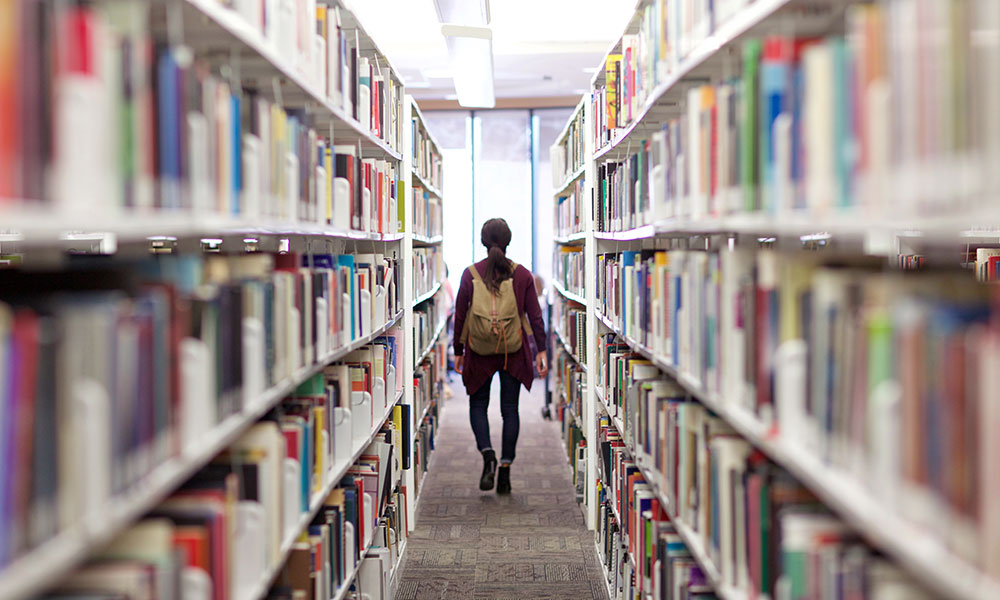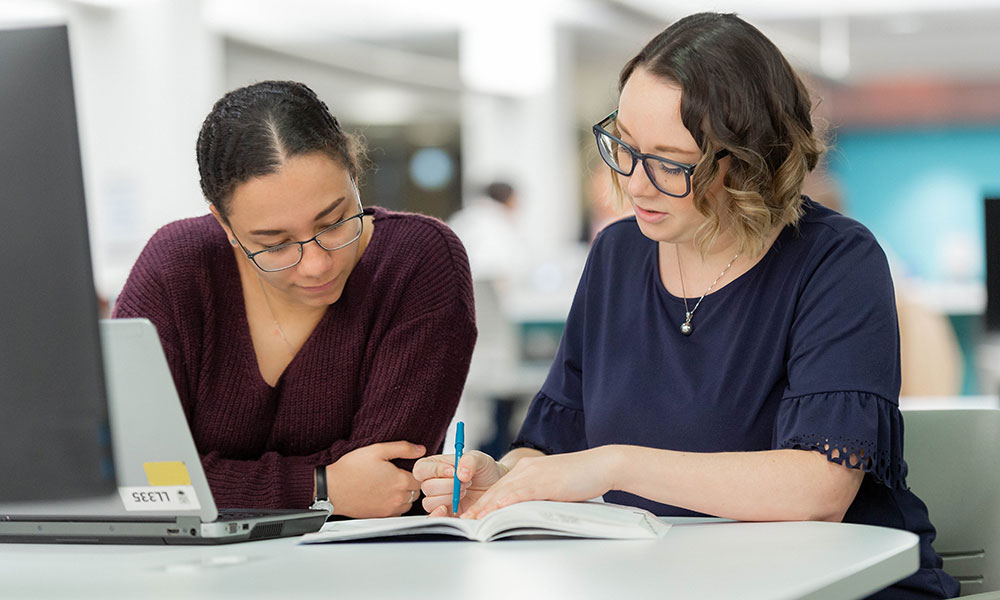
COBWEBS, DUSTY BOOKSHELVES AND LIBRARIANS IN CARDIGANS—thanks to Hollywood, this is often what we imagine when we think of libraries. And although these stereotypes persist in film and fiction, they do little to represent the work that happens in academic libraries today to meet the needs of innovative researchers and diverse members of a library community.
UBC Okanagan Library employees are working collaboratively to critically consider the library’s spaces, services, resources and collections, with the intention of improving inclusivity for students, faculty, staff and community members.
Inclusive library spaces
Traditionally, library spaces have been based on antiquated designs featuring static furniture built for certain activities and people with assumed abilities and preferences. Central to this imagined library space is the intimidating reference desk—usually enormous and made of dark wood.
Imagining a space that could better serve students, Barbara Sobol, public services librarian, began to investigate how UBCO Library might improve accessibility in its spaces and services.
At the time, the library had a large circular standing desk and stationary bench seating. In her research, Sobol found that although many people assume that everyone is equally comfortable approaching a reference desk for support, this assumption fails to consider accessibility challenges. It also fails to address historical, cultural and other social implications that can prevent people—especially those from historically marginalized communities—from approaching a reference desk. This can even prevent them from entering a library in the first place.
“Libraries are a unique type of public good, with a specific social and historical context,” explains Sobol. “How can we reconceptualize libraries with inclusivity and diversity prioritized alongside founding values? This challenging question has implications for all aspects of our work.”
In 2018, the library renovated its main floor, removing the large, wooden reference desk and replacing it with several smaller, streamlined and height-adjustable service desks. While the renovation improved accessibility for people using wheelchairs and other assistive technologies, it also made seeking support at the service desks less intimidating and more approachable. The overall design is intended to convey openness and collaboration.
These renovations built upon improvements to service inclusivity that began in 2014 with the establishment of the Inclusive Technology Lab. In partnership with the Disability Resource Centre and with generous donor funding, the Inclusive Technology Lab supports students with diverse abilities. Chairs have ergonomic options, workspaces are height adjustable, and computers are loaded with assistive software to support text-to-speech, magnification and other activities. Technology on loan includes keyboards, mice, headsets and other devices to enable equitable learning and studying practices.
“There’s a distinct need on campuses and in communities for libraries to provide a unique form of public space,” says Sobol. “Our library is focused on making services and spaces more inclusive.”
For instance, the recently constructed Commons building that adjoins the library includes a breastfeeding room, gender-neutral washrooms and flexible studying environments designed to meet the needs of diverse individuals.
These actions begin to address the question Sajni Lacey, a learning and curriculum support librarian at UBC Okanagan, continues to ask: “How do we create space for students with lived and cultural experiences so they see themselves and their lives reflected in our collections, instruction and library spaces?”
Although developing inclusive library spaces can help improve the university experience, the COVID-19 outbreak has demonstrated that spaces and buildings cannot be depended upon to foster inclusive experiences. Many of the often-visited UBCO Library spaces have been closed during the pandemic, meaning librarians and staff have had to foster inclusivity and provide services, resources and programming virtually.

Digital collections and equitable access
One of the greatest challenges for new university students is figuring out what sources are the most appropriate to use in their research. At one time, this was a more straightforward exercise, achieved by simply scanning the appropriate shelf and borrowing a stack of hardback books and print journals related to a topic.
But as Sobol emphasizes, “The value of browsing our shelves declines every year as we move more online.” The books on the shelves no longer reflect all of the resources the UBCO Library has available.
In addition, there has been a growing interest in Open Educational Resources (OERs) at UBC Okanagan. OERs are openly licensed teaching and learning materials that are free of charge to students and allow instructors to create, share, collaborate and customize their teaching materials. “Open access is a social justice issue,” says Open Education Librarian Donna Langille. “OERs increase equitable access to information.”
“Open access is a social justice issue. Open Educational Resources increase equitable access to information.”
Further, the UBCO Library collaborates with community organizations in the province to build access to historical and primary source materials through digitization and a searchable online portal. With generous donor support, the British Columbia Regional Digitized History (BCRDH) initiative—associated with UBCO Library’s Okanagan Special Collections—extends access to archival materials to students, scholars and the public. “The BCRDH initiative represents an expansion of collections beyond the physical instance of the library, and helps ensure durable access,” says Archivist Paige Hohmann.
Although the COVID-19 outbreak has shown the value of OERs and the importance of having digital resources, supports and collections online—especially during remote learning—it can’t be the only option, explains Collections Librarian Arielle Lomness. “Print will still have a space for a variety of reasons, whether it’s accessibility, preference, being the sole option or simply preservation.”
She adds that there’s a fine balance to attaining and maintaining both print and digital collections in order to meet the demands of different researchers and library patrons.
Critical literacy
Along with the general move toward ebooks, ejournals and other digital resources, click-bait and false reporting have become more prevalent, making it increasingly difficult for students to distinguish between reliable and unreliable sources. The plethora of information and opinions to be found on a topic can be overwhelming. It is the role of librarians and library staff to assist students with navigating the tremendous volume of information and misinformation available. However, just because a text has been peer-reviewed and published in an academic journal doesn’t mean it is an appropriate source.
“Students need to think critically about everything they’re engaging with, including the authorship and wider-narrative context of the materials they’re considering as sources,” explains Lacey. “This skill is critical both in and outside the university context.”
She adds that historical systems of oppression have resulted in some voices being amplified while others are ignored or silenced.
“To move the library into the future as a place of research, learning and engagement, we need to acknowledge our past, including our contribution to systems of oppression and racism,” explains Lacey. As an example, she describes how academic libraries are governed by Western classification systems that can perpetuate assimilation and prioritize Eurocentric points of view.

Collections Librarian Arielle Lomness, right, with a student.
Lacey emphasizes that it’s important to examine the privilege that allows some to publish in academic journals while others only have social media as platforms. This means that sometimes open-sourced and social media platforms, like personal blogs or Twitter, can provide platforms for some knowledge experts. Depending on the requirements of an assignment, it might be appropriate to include sources from non-academic resources. Examples of these materials might include an oral history as told by an Elder, a quotation from TikTok footage of a Black Lives Matter protest or a blog post written by a transgender author.
She adds, “Thinking critically about instruction is essential to moving our conversations and practices forward in terms of anti-racist, decolonized perspectives.”
In the same way that librarians can help educate researchers about the possible relevance of non-traditional formats, they can also encourage students to be critical of age-old canonized texts and traditionally upheld subject experts.
Like most academic libraries, preservation is a key role for UBC Library. This means that some of the books and resources in the collections are offensive and contain expressions of bigotry and racism. And although censorship is not the library’s role, librarians can help contextualize these texts. For example, Lacey is working with partners from UBC’s Xwi7xwa Library and Education Library to spearhead the creation of Critical Literacy Kits. These kits provide insight into problematic texts and encourage researchers to pose questions about the authorship and purpose of a text.
“As librarians, we are trying to establish the foundation on which students can grow and develop in their disciplines as information-literate individuals,” says Lacey.
The student perspective
It can be hard for students to feel like their voices are being heard at university. With an understanding of how vital the student perspective is to inclusivity initiatives, Lacey developed two equity, diversity and inclusion student-intern positions at the UBC Okanagan Library. Aimed at helping the library understand how to create more inclusive practices and spaces, they not only gave their perspectives as students, but more importantly as students with diverse backgrounds and unique experiences.
Hired in September 2020, Taya Jardine—a cultural studies major and Indigenous studies minor—and Atmaza Chattopadhyay—majoring in philosophy, politics and economics with a minor in gender and women studies—were already passionate about advocacy and inclusion work. Their role was to help the library build connections with diverse student groups and support inclusive communities—and all of this was done with the added challenge of the COVID-19 outbreak.
One impactful project involved creating virtual library research guides and social media campaigns that celebrated literature and films from diverse communities. Chattopadhyay’s varied projects have included collaborations with the Muslim Students Association and the African Caribbean Student Club; the development of a social media campaign featuring trans literature; and a project encouraging students to submit their favourite queer literature recommendations so the library could purchase new titles.

UBCO student Taya Jardine.

UBCO student Atmaza Chattopadhyay.
Chattopadhyay explains that it’s important for IBPOC and 2SLGBTQIA+ people to see themselves reflected in the library’s spaces, collections and promotions. “I found it incredibly satisfying to provide virtual spaces to celebrate literature from diverse communities, and for students to make requests from the ground up.” She adds that when done with authenticity, this important work can help signal to students from historically marginalized communities that they are welcome.
Jardine is now at work on the creation of an Okanagan research guide modelled after the Musqueam research guide developed by Xwi7xwa Library on UBC’s Vancouver campus. This important work will provide the community and everyone at UBC with a valuable resource to learn more about the Syilx Okanagan Nation—on whose traditional, ancestral, and unceded territory UBC Okanagan is located—in a respectful manner.
“Building that core relationship between visitor and nation is really important,” says Jardine. “As an Indigenous student, that’s been really important to my experience. Every student should have a place to go to learn about the Syilx community and that they are here and important to our campus.”
Both Chattopadhyay and Jardine agree that they’ve had an impactful experience working for UBCO Library.
“I think it’s beautiful that we were asked to use our student perspectives to guide our work,” says Chattopadhyay.
Equity, diversity and inclusion committee
Improving the experiences of diverse campus community members is critical when offering inclusivity initiatives, which must be done with authenticity and intention. An important step for the library was the development of its own Equity, Diversity and Inclusion Committee, made up of librarians, library staff, student staff and members from UBC Okanagan’s Equity and Inclusion Office and Disability Resource Centre.
According to Lacey, the committee hopes to develop knowledge and structures of practice that focus on equity, inclusion and diversity. She points to recent tangible first steps such as an online book club that met weekly over the summer months to discuss each chapter of Ibram X. Kendi’s How to be an Antiracist.
“Creating an inclusive library of the future requires everyone’s help to make it happen; we need to learn and unlearn together.”
“Creating an inclusive library of the future requires everyone’s help to make it happen; we need to learn and unlearn together,” she says, adding that the book club helped create a virtual space for intentional conversation and learning.
While Lacey admits there is a significant amount of work yet to be done, she and her fellow committee members are encouraged by the support received so far.
“We’re excited to see a commitment to resourcing inclusive practices coming from library and university administrative levels,” Lacey explains. “This enthusiasm from the top will help us implement our grass-roots efforts.”


